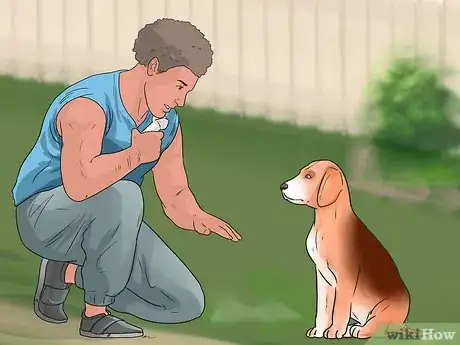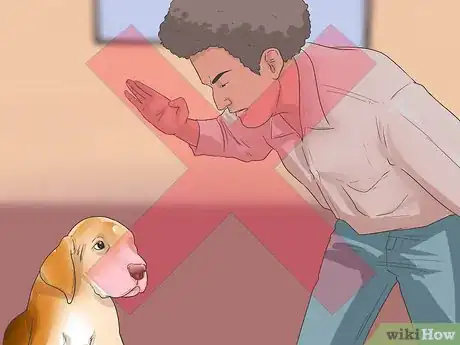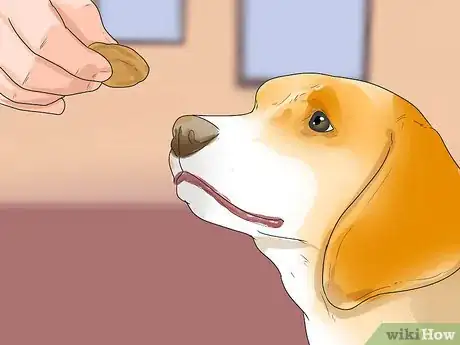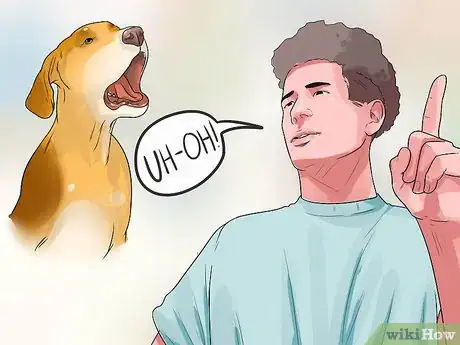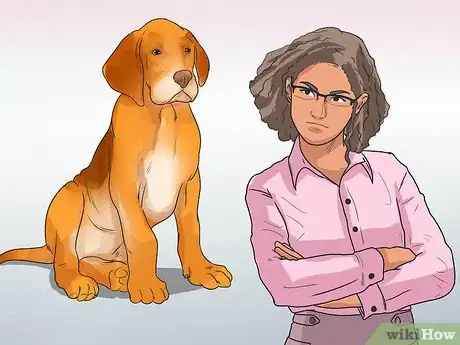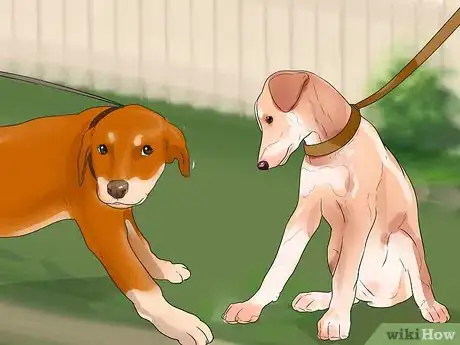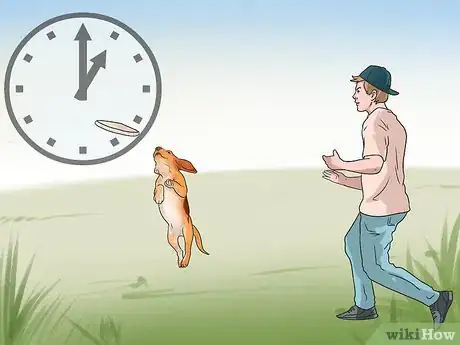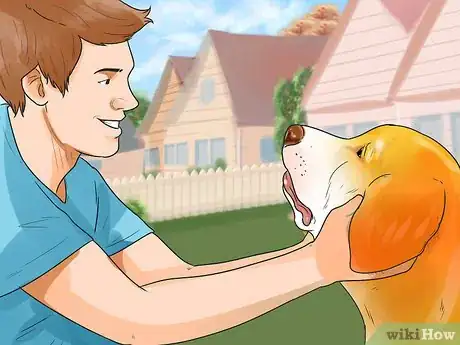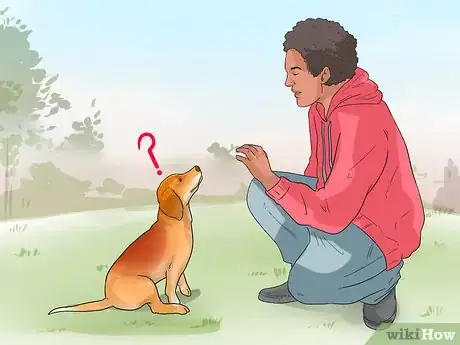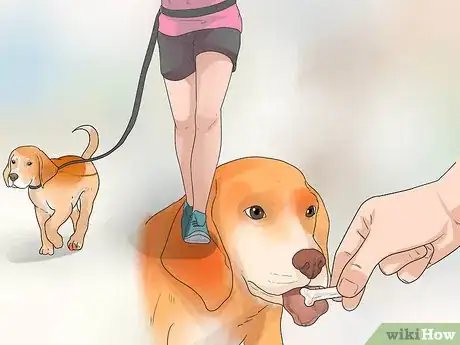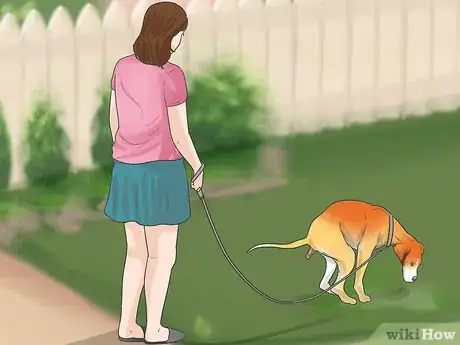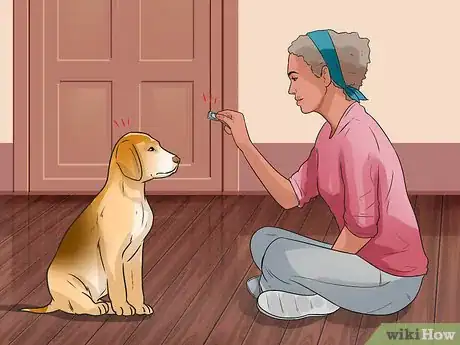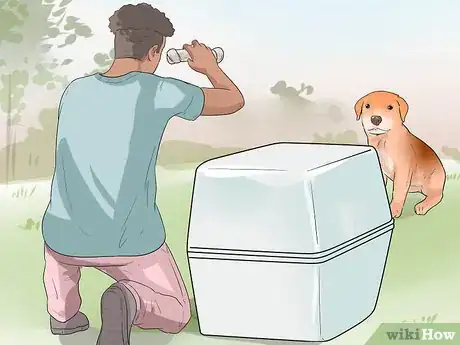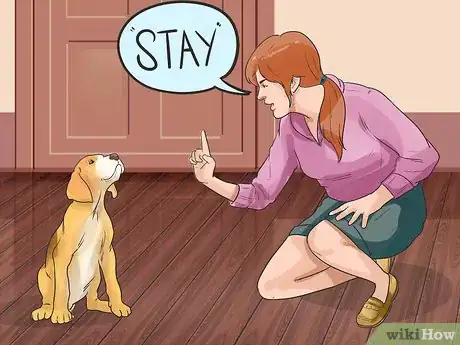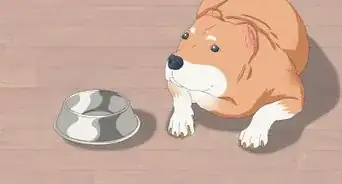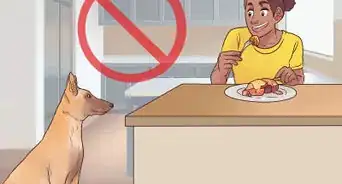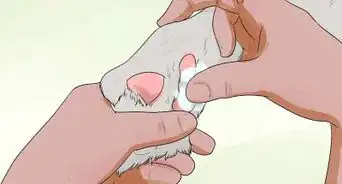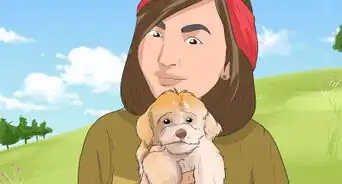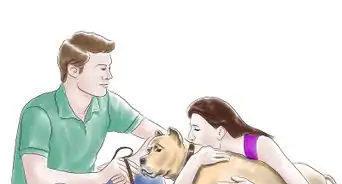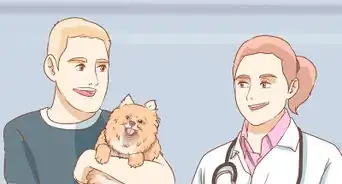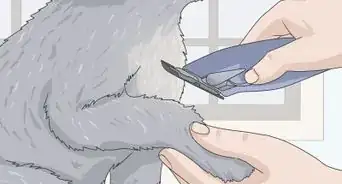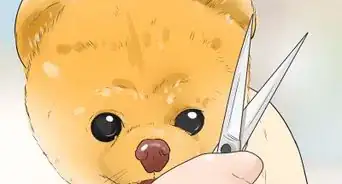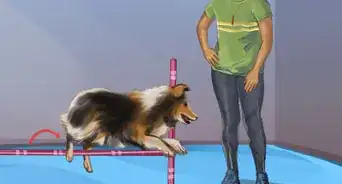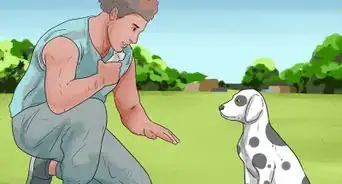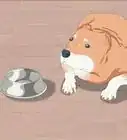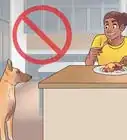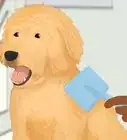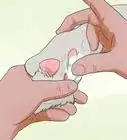This article was co-authored by Brian Bourquin, DVM. Brian Bourquin, better known as “Dr. B” to his clients, is a Veterinarian and the Owner of Boston Veterinary Clinic, a pet health care and veterinary clinic with three locations, South End/Bay Village, the Seaport, and Brookline, Massachusetts. Boston Veterinary Clinic specializes in primary veterinary care, including wellness and preventative care, sick and emergency care, soft-tissue surgery, dentistry. The clinic also provides specialty services in behavior, nutrition, and alternative pain management therapies using acupuncture, and therapeutic laser treatments. Boston Veterinary Clinic is an AAHA (American Animal Hospital Association) accredited hospital and Boston’s first Fear Free Certified Clinic. Brian has over 19 years of veterinary experience and earned his Doctor of Veterinary Medicine from Cornell University.
wikiHow marks an article as reader-approved once it receives enough positive feedback. In this case, 86% of readers who voted found the article helpful, earning it our reader-approved status.
This article has been viewed 60,317 times.
Great Danes are huge but gentle dogs. When fully grown, Great Danes can grow to two feet and 10 inches at the shoulder and weigh up to 200 pounds.[1] Great Danes make great guard dogs because their sheer physical presence is typically enough to intimidate burglars. Because they are so large, Great Danes should be well trained from an early age. If they misbehave at an older age, you will likely not be able to physically move or restrain your Great Dane. If you have some patience and take your time, you can learn to train your Great Dane.
Steps
Undertaking Dog Training Basics
-
1Start early. Great Danes have an innate need to please, so your puppy will be easy to train.[2] Since your Great Dane is so large, it is important to start as early as you can to help him learn good behavior. This will ensure that, as he grows, he will listen to you and follow your lead. This will be easier for you because he will be harder to convince to do things the older and larger he gets.
- The earliest you can start to train your Great Dane is at around eight to10 weeks old.[3]
-
2Never beat your dog. Punishing or beating your Great Danes when he is not acting in the way you want him to is out of the question. Instead of learning from your punishment, your Great Dane will learn to be scared of you or learn to hate you. If your Great Dane behaves out of fear of punishment from you, your dog may become frustrated or anxious. This may lead pent up anger which may cause your Great Dane to become aggressive.
- Given the size of a Great Dane, you could be a danger if the aggressive behavior is turned on you. This means that it is even more imperative for such a large dog.[4]
Advertisement -
3Reward your Great Dane for proper behavior. Training through rewards is the best method to get your Great Dane to train properly. It is more constructive as a training method because your dog will associate your training with pleasant things. Whenever you give a particular command, reward your Great Dane's behavior with a treat or other positive reinforcement.[5]
- This will connect your dog's behavior with the pleasant feeling.
- Begin with easy commands, such stay or sit. [6]
-
4Express dissatisfaction firmly and calmly. If your Great Dane is behaving badly or is engaging in behavior that he shouldn't, you should give short, sharp commands in a calm voice. This should be a phrase, such as "No" or "Uh oh", that you say firmly to him.
- Once your Great Dane corrects his behavior, you can praise him for that behavior.
- Even if your Great Dane does not respond right away, do not get upset, yell, or hit your dog. This will only make him fear you. [7]
-
5Be patient. No portion of training your Great Dane will happen over night. You just have to keep with all the different types of training. Your dog will eventually catch on as long as you stick with it.
- If a particular treat is not working, mix it up. If the training method is not working just right, switch up how you are approaching it to ensure that you are reaching your dog and training them as successfully as possible.[8]
-
6Socialize your dog early. Your Great Dane needs to be introduced to other dogs and people early in his life. This will ensure that your Great Dane acts accordingly around other dog and people. To do this, take him to a dog park, invite people to your house, or enroll him in socialization classes, which are given by professionals.
- This is especially important for your Great Dane because, if he attacks other dogs or people, he can do major damage.[9]
- Be sure that your Great Dane has all his shots before you take him around other dogs.
Structuring Your Training Sessions
-
1Keep training sessions short. When you are training your Great Dane puppy, you should keep your sessions short. They should last no longer than five minutes at first. Your Great Dane puppy will have a very short attention span, so you need to make sure you can keep his attention by having short training sessions.
- As he gets older, you can increase the length of your sessions.[10]
-
2End on a positive note. Make sure you stop your training sessions on a positive note. Once you notice your Great Dane puppy getting distracted, go ahead and quit your session. End it by requesting him to do a simple command that you know your Great Dane can perform. This way, you will be able to praise him at the end of the session.
- This will leave your puppy feeling happy with himself, which will make him a happier dog.[11]
-
3Make treats less predictable. Your Great Dane will eventually get used to the treat and reward schedule that you developed in the beginning. When this happens, you should make your schedule and methods much less predictable. Instead of giving a treat every time you Great Dane does something right, skip a few to keep him guessing.
- This makes him wonder why he didn't get a treat and will make him work harder in the future to get the next treat or reward.
- Over time, skip two or three instances that you would typically reward until you are only rewarding every fourth or fifth behavior. This will be far enough apart for him to work for it but close enough together to encourage good behavior. [12]
-
4Change up the rewards. When you reward your Great Dane, try to vary the types of treats you give him. These treats don't have to be food related and can vary depending on your or your dog's mood. Try bites of food, dog treats, praise, or play time with his favorite toy.
- Your Great Dane will let you know which activities he likes the best. This may be tugging on his favorite chew toy or eating a bite of his favorite treat.
- You should also use different treats on different days.[13]
Training Your Dog for Specific Things
-
1Potty train your dog. When you are potty training your Great Dane puppy, you need to start as early as possible when you bring him home. Start by designating a specific place in your back yard that will be his toilet place. Take him there every 20 to 30 minutes at first, changing to once an hour as he gets older. When he uses it, praise him and give him affection and attention. This will help your Great Dane think about your praise of him when he needs to use the bathroom, which will make him more likely to repeat his good behavior.
- Make sure you praise him every time he potties in the right place.
- To properly potty train your Great Dane, keep a watch on him all the time while he is indoors. This means you need to follow him around, keep him in his crate while you go out, or keep him on a leash.
- If your dog does mess in the house on accident, make sure you clean the area extremely well to remove the smell. This will make sure he will not return to mark the same territory again.[14]
-
2Use clicker training for your dog. Clicker training is a great way of designating desired behavior for your Great Dane. It will also help him know what he is being rewarded for. Clicker training works by linking the click-clack of the clicker to him getting a reward for his behavior.[15]
- When you get the desired action from your Great Dane, use the clicker to reinforce it.
- For example, when teaching your Great Dane to "sit", press the clicker as soon as your dog's bottom hits the ground. [16]
-
3Train your dog for a crate.[17] Crate training will give your dog a small room of his own. Start with a crate large enough for your Great Dane puppy to walk around. Put a comfortable bed in his crate along with a water bowl and some toys. Keep your puppy in here when you have to leave to discourage messing in the house or chewing things he shouldn't.
- To get your Great Dane used to the crate, close the door when he goes inside. Leave him in the crate for short periods of time, gradually increasing them until he can stay there for hours without whining. Give him lots of praise when he sits in there well.
- To help him associate his crate with happy things, give him treats or a toy when you keep him in there.
- As he grows, the crate will need to be bigger. If you don't want to buy another crate as he grows, buy a large crate to begin with. It should be large enough for him not to bang his head and long enough for him to lie down.[18]
-
4Teach simple commands. To ensure your Great Dane behaves himself, he needs to learn to obey basic commands such as "Sit", "Stay", and "Come". If your Great Dane obeys these as soon as you give them, you can control him in pretty much any situation.[19] Try using food, small treats, or other foods to help train your dog.
- For example, put a treat in your hand. Let your Great Dane know you have it. Use the hand with the treat to lure his head upwards until his bottom naturally hits the ground.. As you put his bottom on the ground, say firmly and calmly "Sit". You can also press the clicker as soon as his bottom hits the floor. Then give him the treat.[20]
- Similar methods work for other basic commands.
Expert Q&A
-
QuestionHow do you train a Great Dane to walk on a leash?
 Pippa Elliott, MRCVSDr. Elliott, BVMS, MRCVS is a veterinarian with over 30 years of experience in veterinary surgery and companion animal practice. She graduated from the University of Glasgow in 1987 with a degree in veterinary medicine and surgery. She has worked at the same animal clinic in her hometown for over 20 years.
Pippa Elliott, MRCVSDr. Elliott, BVMS, MRCVS is a veterinarian with over 30 years of experience in veterinary surgery and companion animal practice. She graduated from the University of Glasgow in 1987 with a degree in veterinary medicine and surgery. She has worked at the same animal clinic in her hometown for over 20 years.
Veterinarian Start in a place with few distractions, such as a backyard. My preference is the "Stop and sit" method. With the dog on a leash, walk forward; if the dog surges ahead, stop and wait for them to sit. Then reward and start walking again. The dog soon learns to keep to heel, or else they have to stop and sit.
Start in a place with few distractions, such as a backyard. My preference is the "Stop and sit" method. With the dog on a leash, walk forward; if the dog surges ahead, stop and wait for them to sit. Then reward and start walking again. The dog soon learns to keep to heel, or else they have to stop and sit. -
QuestionAre Great Danes easy to train?
 Pippa Elliott, MRCVSDr. Elliott, BVMS, MRCVS is a veterinarian with over 30 years of experience in veterinary surgery and companion animal practice. She graduated from the University of Glasgow in 1987 with a degree in veterinary medicine and surgery. She has worked at the same animal clinic in her hometown for over 20 years.
Pippa Elliott, MRCVSDr. Elliott, BVMS, MRCVS is a veterinarian with over 30 years of experience in veterinary surgery and companion animal practice. She graduated from the University of Glasgow in 1987 with a degree in veterinary medicine and surgery. She has worked at the same animal clinic in her hometown for over 20 years.
Veterinarian Great Danes are moderately easy to train, but their sheer size and laid-back nature can make it hard work at times. If a Great Dane doesn't want to get up, you can't force them and they quickly realize this. Motivation in the form of treats, praise, and play is crucial to getting their attention and keeping it.
Great Danes are moderately easy to train, but their sheer size and laid-back nature can make it hard work at times. If a Great Dane doesn't want to get up, you can't force them and they quickly realize this. Motivation in the form of treats, praise, and play is crucial to getting their attention and keeping it. -
QuestionHow do you house train a Great Dane?
 Pippa Elliott, MRCVSDr. Elliott, BVMS, MRCVS is a veterinarian with over 30 years of experience in veterinary surgery and companion animal practice. She graduated from the University of Glasgow in 1987 with a degree in veterinary medicine and surgery. She has worked at the same animal clinic in her hometown for over 20 years.
Pippa Elliott, MRCVSDr. Elliott, BVMS, MRCVS is a veterinarian with over 30 years of experience in veterinary surgery and companion animal practice. She graduated from the University of Glasgow in 1987 with a degree in veterinary medicine and surgery. She has worked at the same animal clinic in her hometown for over 20 years.
Veterinarian Use the same principles as for any pup: avoid accidents by offering regular toilet trips outside, and lots of praise when they do go in the right spot. Prevent indoor accidents by watching the dog all the time, and when you can't do this, use a crate.
Use the same principles as for any pup: avoid accidents by offering regular toilet trips outside, and lots of praise when they do go in the right spot. Prevent indoor accidents by watching the dog all the time, and when you can't do this, use a crate.
References
- ↑ http://dogtime.com/dog-breeds/great-dane
- ↑ http://dogtime.com/dog-breeds/great-dane
- ↑ https://www.dogstrust.org.uk/help-advice/factsheets-downloads/basicdogtrainingfactsheetnov13.pdf
- ↑ http://dogtime.com/dog-breeds/great-dane
- ↑ Brian Bourquin, DVM. Veterinarian. Expert Interview. 20 December 2019.
- ↑ https://www.dogstrust.org.uk/help-advice/factsheets-downloads/basicdogtrainingfactsheetnov13.pdf
- ↑ http://www.clickertraining.com/get-started
- ↑ http://www.thekennelclub.org.uk/getting-a-dog-or-puppy/general-advice-about-caring-for-your-new-puppy-or-dog/toilet-training-for-puppies/
- ↑ http://dogtime.com/dog-breeds/great-dane
- ↑ https://www.dogstrust.org.uk/help-advice/factsheets-downloads/basicdogtrainingfactsheetnov13.pdf
- ↑ https://www.dogstrust.org.uk/help-advice/factsheets-downloads/basicdogtrainingfactsheetnov13.pdf
- ↑ https://www.dogstrust.org.uk/help-advice/factsheets-downloads/basicdogtrainingfactsheetnov13.pdf
- ↑ https://www.dogstrust.org.uk/help-advice/factsheets-downloads/basicdogtrainingfactsheetnov13.pdf
- ↑ http://www.thekennelclub.org.uk/getting-a-dog-or-puppy/general-advice-about-caring-for-your-new-puppy-or-dog/toilet-training-for-puppies/
- ↑ http://www.clickertraining.com/get-started
- ↑ http://www.clickertraining.com/get-started
- ↑ Brian Bourquin, DVM. Veterinarian. Expert Interview. 20 December 2019.
- ↑ http://dogtime.com/dog-breeds/great-dane
- ↑ http://dogtime.com/dog-breeds/great-dane
- ↑ http://dogtime.com/dog-breeds/great-dane
About This Article
To train your Great Dane, start by limiting training sessions to 5 minutes and gradually increasing them, since Great Danes have short attention spans. Additionally, end each training session by giving your dog a command it already knows, so you always finish on a positive note. You should also give it a variety of rewards, like treats, verbal praise, and play time, to keep it excited and motivated to learn. For more tips from our Veterinary co-author, including how to crate train your Great Dane, read on!
